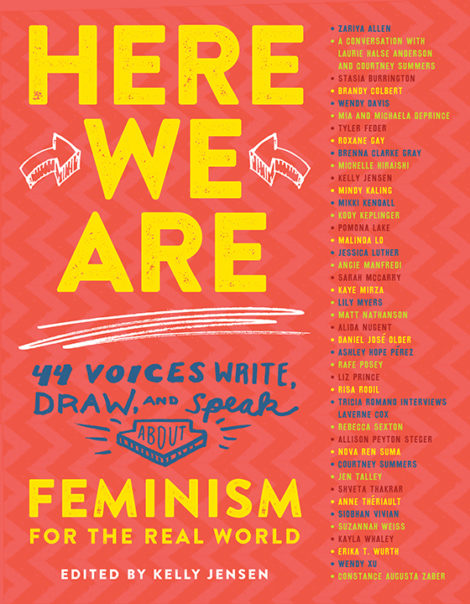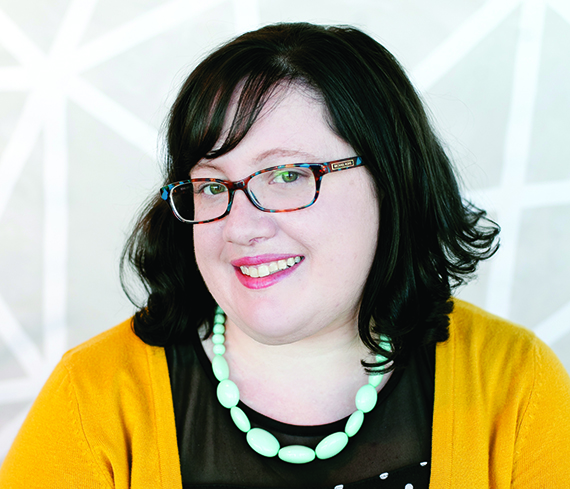
HERE WE ARE
Feminism For The Real World
Let’s get the feminist party started!
Here We Are is a scrapbook-style guide to understanding what it means to be a twenty-first-century feminist. It’s packed with contributions from a diverse range of voices, including TV, film, and pop-culture celebrities and public figures such as ballet dancer Michaela DePrince and her sister Mia and politician Wendy Davis, as well as popular authors like Nova Ren Suma, Malinda Lo, Brandy Colbert, Courtney Summers, and many more. All together, the book features more than forty-four pieces and illustrations.
Here We Are is a response to lively discussions about the true meaning of feminism on social media and across popular culture and is an invitation to one of the most important,
Let’s get the feminist party started!
Here We Are is a scrapbook-style guide to understanding what it means to be a twenty-first-century feminist. It’s packed with contributions from a diverse range of voices, including TV, film, and pop-culture celebrities and public figures such as ballet dancer Michaela DePrince and her sister Mia and politician Wendy Davis, as well as popular authors like Nova Ren Suma, Malinda Lo, Brandy Colbert, Courtney Summers, and many more. All together, the book features more than forty-four pieces and illustrations.
Here We Are is a response to lively discussions about the true meaning of feminism on social media and across popular culture and is an invitation to one of the most important, life-changing, and exciting parties around.
- Algonquin
- Paperback
- January 2017
- 256 Pages
- 9781616205867
About Kelly Jensen
 Kelly Jensen is a former librarian-turned-editor for Book Riot and Stacked. She’s author of It Happens: A Guide to Contemporary Realistic Fiction for the YA Reader. She loves black licorice and debating genre.
Kelly Jensen is a former librarian-turned-editor for Book Riot and Stacked. She’s author of It Happens: A Guide to Contemporary Realistic Fiction for the YA Reader. She loves black licorice and debating genre.
Praise
“Sophisticated yet entirely accessible, the collection is valuable both for the breadth of thought and perspective it represents and for the support it directs toward readers.” —Publishers Weekly, starred review
“A stellar collection of writings—prose, illustrated pieces, and poetry—that showcase contemporary expressions of feminism: what it is, what it isn’t, and what it can be. . . An embarrassment of riches.” —Kirkus Reviews, starred review
“[Here We Are] boldly celebrates and analyzes feminism as it exists today . . . An education unto itself, the message of inclusion and strength is an invaluable.” —Booklist, starred review
“There is something here for everyone.” —School Library Journal, starred review
Discussion Questions
1. After reading this collection of essays and art about feminism, how would you define what being feminist means?
2. What is the significance of the title of this book, Here We Are: Feminism for the Real World?
3. Which essays resonated most with you as a reader? What made those particular pieces stand out?
4. Discuss some of the different ways the contributors incorporate feminism into their daily lives.
5. Take a few moments and imagine yourself as a superheroine/superhero using the guide in the essay by Allison Peyton Steger and Rebecca Sexton. What does your superheroine/superhero self look like? What are your strengths? Your weaknesses? How does reading about feminism have an impact on the way you see yourself as a superheroine/superhero?
6. In addition to essays, Here We Are also contains drawings, comics, photographs, and poems. What do these pieces say about feminism? What other works of art, current and/or historical, do you consider to be feminist?
7. What does the design of this book add to the pieces themselves? Does the scrapbook-like look and feel change how you approach reading the collection?
8. Intersectionality plays a part in each of the essays in this collection, but it is central in the pieces by Mikki Kendall, Constance Augusta Zaber, and Kaye Mirza. What defines intersectionality? How do these essays showcase the importance of intersectional feminism?
9. Three pieces in the collection (by Kayla Whaley, Erika T. Wurth, and Siobhan Vivian) take the form of letters to one’s younger self. If you could talk about feminism with your younger self, what wisdom would you impart?
10. Do you think what you’ve learned about feminism will have an impact on your future? How? In what ways can you declare your feminism and integrate it into your everyday life? Are there any pieces of advice or nuggets of wisdom from this collection that you will take with you?
